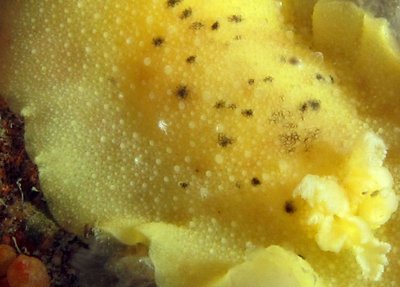Page 1 of 1
Two for ID help
Posted: Sun Jan 13, 2013 10:26 pm
by LCF

Heath's (but it doesn't have the patch of dark spots in front of the gill plume)? Very pale nobilis?

Hairy orange hermit? There were two of these guys at the base of the jetty at Edmonds, and I have never seen a hermit crab a) so big and b) so hairy.
Re: Two for ID help
Posted: Sun Jan 13, 2013 11:02 pm
by Dusty2
It's a heath's they don't all have that spot. As for the crab I'll let Greg do that one
Re: Two for ID help
Posted: Mon Jan 14, 2013 7:29 am
by dwashbur
Definitely Heath's. I usually identify them by their overall shape, because they always looks like they just got stepped on.
Re: Two for ID help
Posted: Mon Jan 14, 2013 11:43 am
by Jan K
Lynne, here are some color variation I found here on Whidbey :

Re: Two for ID help
Posted: Mon Jan 14, 2013 11:53 am
by LCF
Interesting that none of those has the "blotch" the book describes, and the yellow one has a yellow gill plume.
Re: Two for ID help
Posted: Mon Jan 14, 2013 12:57 pm
by Dusty2
The id factor I use is the texture. Each of the yellow nudibranchs has it's own distinct skin texture. Color, spots, can vary greatly and many of the books use examples form other areas which can be wildly different but the texture remains the same. Look at the leopard nudie described in Dave's book, it looks nothing like they do up here. There are many such examples.
Re: Two for ID help
Posted: Mon Jan 14, 2013 3:17 pm
by Greg Jensen
Hermit is a hairy hermit, Pagurus hirsutiusculus. The blue markings on the legs don't show up very well on really big, old fuzzy guys like this one.
Re: Two for ID help
Posted: Mon Jan 14, 2013 3:22 pm
by LCF
Thanks, Greg! This was HUGE crab, for a hermit -- probably 2 1/2 inches across, maybe more. First one I can remember seeing.
Re: Two for ID help
Posted: Fri Jan 18, 2013 9:30 am
by Tubesnout23
LCF wrote:Thanks, Greg! This was HUGE crab, for a hermit -- probably 2 1/2 inches across, maybe more. First one I can remember seeing.
I was wondering what kind of species that crab was too. The thing that I found unusual was its dark color and the fact that its body was so large that it could not fit it all inside that small shell. As Lynne pointed out to me:"It looked like an underwater tarantula"...I will always remember that!

Great pictures Lynne!
Re: Two for ID help
Posted: Fri Jan 18, 2013 9:36 am
by Tubesnout23
dwashbur wrote:Definitely Heath's. I usually identify them by their overall shape, because they always looks like they just got stepped on.
So what's the difference between a Heath's and a Monterey Sea Lemon?
Re: Two for ID help
Posted: Fri Jan 18, 2013 10:32 am
by LCF
Monterey dorids have "bumpier" tubercles and are more pickle-shaped than flat; Heath's have those color blotches on the skin, flatter tubercles, and the gill plumes match the skin color. At least that's what I'm getting from the feedback on these photos in various places.
Re: Two for ID help
Posted: Fri Jan 18, 2013 10:43 am
by Dusty2
Tubesnout23 wrote:So what's the difference between a Heath's and a Monterey Sea Lemon?
As I said earlier, Texture and general shape are the two main factors.
The Heaths will tend to be flat with thin frilly looking edges. They look like they have skin covered with tiny warts. Their rinophores are stubby and usually withdrawn and you seldom catch them with their gills out.
Heaths texture

- Heaths texture
The Monterey's are covered with tiny little cone shaped spikes and the body is very rounded in shape. The gills and rinophores will always be yellow and the black spots will cover the spikes which they do not on the heaths.
Re: Two for ID help
Posted: Sat Jan 19, 2013 9:00 pm
by Tubesnout23
Dusty2 wrote:Tubesnout23 wrote:So what's the difference between a Heath's and a Monterey Sea Lemon?
As I said earlier, Texture and general shape are the two main factors.
The Heaths will tend to be flat with thin frilly looking edges. They look like they have skin covered with tiny warts. Their rinophores are stubby and usually withdrawn and you seldom catch them with their gills out.
Heaths texture
Heaths.JPG
The Monterey's are covered with tiny little cone shaped spikes and the body is very rounded in shape. The gills and rinophores will always be yellow and the black spots will cover the spikes which they do not on the heaths.
montery.jpg
Thank you very much folks!


